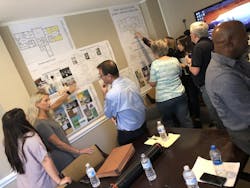Design Students Learn Community Firsthand with Hospital Project
How do university instructors forge relationships with community-based partners that satisfy requirements of the academy while yielding project results that justify its partner’s time and commitment?
Design professionals who serve as university instructors have the benefit of transferring lessons learned in the field to the classroom. Such is the case here.
As design professionals, our work in communities has taught many of us to see “places” from the perspective of those who live there. This inspires us to collaborate with them on common goals and tangible outcomes. Because of stakeholder eagerness to sustain the momentum for change fostered during collaboration, we have learned to generate short-term results from a long-term vision.
Professionals have also seen universities attempt participation in this type of community work, at times, to no avail. This happens when the university uses community involvement only to satisfy its grant and pedagogical interests, when the community, on the other hand, was hoping for real answers to difficult challenges.
The lesson is that goals and outcomes must be reciprocating in order to hold the interest of all and to justify the time and sustained commitment. Mutuality must reign. Each participant must accept equal responsibility for the outcome of all interests, not just their own.
Students Learn About Communities Firsthand
The challenge in working with community partners in an academic setting is leading students to see communities as equal partners and not just as resources for their project’s success.
The lessons of collaboration, reciprocation and value of stakeholder participation become important. It’s not until students realize they must begin and end with the stakeholder that transformation from the concept of “I” to “we” occurs.
[Related: Outcome of Design Awards Illustrate How Design Impacts Life]
Students began to see their work as representing something greater than themselves and that they need more than themselves to achieve it. The idea of “partnership” starts to have meaning. They realize that their ideas are no longer self-involved, but more importantly, they are about the needs of those with whom they are partnering.
With this, students accept that listening is more important than being heard, that places hold meaning to those who live in them, that tangible results inspire stakeholders into action, and that their work as designers can make noticeable and immediate differences in people’s lives.
For the last year and a half, the students in the Louisiana State University (LSU) School of Interior Design, through the College of Art + Design, have been working with Northlake Behavioral Health Systems (Northlake) in Mandeville, LA, (about 60 miles from campus) on improvement strategies for their facility and operations.
Northlake is a private, nonprofit hospital that approached LSU seeking low-costs ways to bring an 80-year-old, outdated facility back to relevance in the lives of patients seeking treatment and recovery.
The outdated appearance of the facility conveys a false impression of what happens on the inside. Northlake staff “models caring” and “communal living,” they don’t teach it. They focus on patient identity, not on patient symptoms. This is a progressive approach in the behavioral health industry and one that Northlake staff practices faithfully.
Design and Engagement for Success
After three semesters of working together, starting with a single building, expanded to a patient campus and finally to the entire 35-acre hospital campus, LSU and Northlake have concluded that the growing success of our relationship can be attributed to the commitment of Northlake staff to patient recovery, to the work and enthusiasm of students, and to the design and engagement process that we’ve developed together.
It includes four steps:
1. Relevance
This is about Northlake. It’s born of their culture of care, their limitations of revenue and resources, and their aspirations for the future.
Translated into academic work, students are tasked with devising design solutions for year one, no costs (immediate action); year five, minimal costs; and year 10, strategic investment design solutions. These strategies are tested through mid-semester installations.
2. Collaboration
- Student to Northlake: Four 4-hour workshops, 2 days of installations
- Student to student: Research, design and packaging teams
- Student to instructor: Studio and workshop charrettes around common goals
(Photo: Student Installation- Painting Staff Lounge. Credit: Andrew Baqué)
3. Research
Research breaks-down the “I” syndrome and grounds work in proof and education for the student and for Northlake alike. It was conducted in three areas:
- Northlake feedback
- Evidence-based design
- Best practices and case studies
4. Design
The focus was on staff and patient experiences, patient treatment and recovery, campus and building programming and efficiencies, aesthetics and branding, and improvement costs vs. new revenue.
The design approach was to organize 14 students working on one outcome verses 14 students working on 14 different outcomes. This achieved greater depth in research and richer thoughtfulness in design offerings.
Though some goals remain to be explored further in the 2020 spring semester, such as designing better sensory environments for patient recovery, the reward of this process has been two-fold:
- Northlake has requested the School’s assistance in the implementation of student design strategies from all three semesters.
- The student’s discovery that being a “Responsive Design Partner” in a process that involves “we” is far more fulfilling than a process limited to “I.”
Read next: What’s Next in Design? Look Around Before Looking Forward
